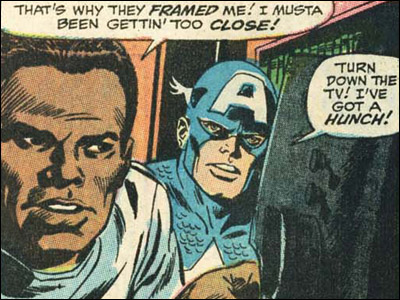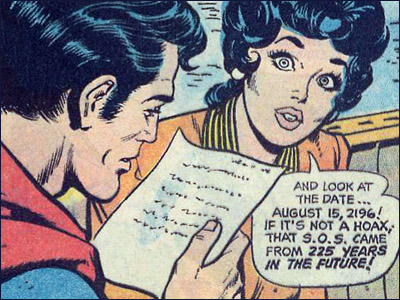For the rest of the weekend, I want to get some stuff on this blog that isn't about You-Know-Who so I thought I'd answer this question from Michael McKeever…
I have been noticing on Facebook and elsewhere, a lot of fans pointing out that on a certain cover by Neal Adams, a figure was redrawn by John Romita or in a certain story by someone else, a panel was drawn by Murphy Anderson. On your list of A List of Things I've Learned About the Comic Book Industry Since I Got Into It In 1970, Many But Not All of Which Still Apply [link], I notice you wrote that "Approximately 50% of editorial alterations made on the work of the writers and artists were made mainly because someone in the office wanted to look like they were making a vital contribution." Could you write something more about this and also about the other 50% of reasons?
Sure. But first of all, let's note that it is completely within the rights and power of an editor (usually) to dictate corrections on a comic that he or she is in charge of. Occasionally, the talent has a contractual guarantee — we had one on Groo when it was published by Marvel — that nothing can be changed without the talent's permission. But those arrangements are rare exceptions and they usually are negotiated in cases where the talent is delivering a finished, ready-to-go-off-to-the-printer book.
Secondly, let's note that just because they ask for a change, that doesn't mean they're right. I see folks on discussion forums notice one of those Romita figures on a Gene Colan cover who assume "Gene must have screwed-up there." Well, maybe and maybe not. The editor thought the drawing needed fixing but maybe it didn't. I've seen editorial decisions I thought were ridiculous…and as I noted, sometimes the only reason for them is that someone wants to change something to assert their standing as The Boss.
Or there's one other reason I'll discuss in a follow-up post to this one.
Also, let's remember that it's easy for some of us to spot a retouch done by John Romita on a Neal Adams page. There were also surely retouches made by John Romita on John Romita pages and retouches by Neal Adams on Neal Adams pages and we can't spot them. If the editor can have the retouch done by the original artist, he or she usually does. Sometimes though, the original artist isn't around, whereas John Romita and a few other guys worked full-time in the Marvel offices. There was a period when Murphy Anderson worked in the DC offices and was called on to do redraws.

Captain America redrawn by John Romita.
Romita went on staff at Marvel around November of 1965 and he became the main guy Stan called on to do retouches when they had to be done quickly. Before that, Sol Brodsky or Carl Hubbell did most of them on staff but Stan also lassoed various freelancers to do such work — for which they were not paid — when they were dropping off pages at the office. Jack Kirby redrew the Spider-Man figure that Steve Ditko drew on the cover of Amazing Spider-Man #10 and Steve Ditko redrew the Spider-Man figure that Jack Kirby drew on the cover of Avengers #11.
Also, let's note that when Romita redrew something on an Adams page, it probably did not mean John said, "Oh, I can draw that so much better than Neal! I'll improve it!" It probably means that John was directed by the editor to "fix" something the editor thought needed "fixing." I have seen artists, including Mr. Romita, making changes with which they did not themselves agree.
And I guess I should mention that one time when I was loitering in the Marvel Bullpen, I saw Marie Severin redrawing a panel in a page by someone else not because anyone thought the artist did a poor or wrong drawing but because someone had spilled ink on the page. That kind of thing happens too.

Superman redrawn by Murphy Anderson.
Now then. Were these changes necessary? Sometimes. The original artist may have drawn something not up to standard — everyone does at times — but more often, it was a matter of the drawing being wrong. Someone drew the wrong character or the wrong action. Or some editor had gotten ultra-fussy about a certain character being drawn a certain way.
When Stan Lee was writing dialogue for a story that was already drawn, he would sometimes think, "Gee, I wish the artist had drawn something else happening in that panel." If he did, he might hand it to Romita and tell him what should be there in its stead. It did not always mean the original artist had erred.
When I work with Sergio Aragonés on Groo, I sometimes ask him to change what's happening in a certain panel and since he makes the change himself, there's no way you can look at the published comic and know. (We also both sometimes have done corrections to the lettering, not because letterer Stan Sakai made a mistake — though in a very rare while, he does — but because we changed our mind about what a character should be saying.)
Lastly for now, there's a special kind of correction/change that is often made on comic book covers. They're changes made because someone in power is nervous. I have an e-mail from someone else asking about this kind of thing so I think I'll end this discussion here and pick up on it in a few days to talk about that kind of correction. Thanks, Michael.
